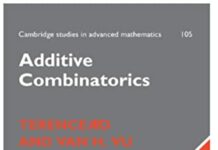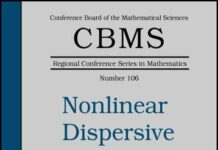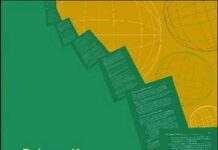
Ebook Info
- Published: 2016
- Number of pages: 218 pages
- Format: PDF
- File Size: 1.73 MB
- Authors: Terence Tao
Description
This is part two of a two-volume book on real analysis and is intended for senior undergraduate students of mathematics who have already been exposed to calculus. The emphasis is on rigour and foundations of analysis. Beginning with the construction of the number systems and set theory, the book discusses the basics of analysis (limits, series, continuity, differentiation, Riemann integration), through to power series, several variable calculus and Fourier analysis, and then finally the Lebesgue integral. These are almost entirely set in the concrete setting of the real line and Euclidean spaces, although there is some material on abstract metric and topological spaces. The book also has appendices on mathematical logic and the decimal system. The entire text (omitting some less central topics) can be taught in two quarters of 25–30 lectures each. The course material is deeply intertwined with the exercises, as it is intended that the student actively learn the material (and practice thinking and writing rigorously) by proving several of the key results in the theory.
User’s Reviews
Editorial Reviews: From the Back Cover This is part two of a two-volume book on real analysis and is intended for senior undergraduate students of mathematics who have already been exposed to calculus. The emphasis is on rigour and foundations of analysis. Beginning with the construction of the number systems and set theory, the book discusses the basics of analysis (limits, series, continuity, differentiation, Riemann integration), through to power series, several variable calculus and Fourier analysis, and then finally the Lebesgue integral. These are almost entirely set in the concrete setting of the real line and Euclidean spaces, although there is some material on abstract metric and topological spaces. The book also has appendices on mathematical logic and the decimal system. The entire text (omitting some less central topics) can be taught in two quarters of 25–30 lectures each. The course material is deeply intertwined with the exercises, as it is intended that the student actively learn the material (and practice thinking and writing rigorously) by proving several of the key results in the theory. About the Author Terence “Terry” Chi-Shen Tao, FAA FRS, is an Australian mathematician. His areas of interests are in harmonic analysis, partial differential equations, algebraic combinatorics, arithmetic combinatorics, geometric combinatorics, compressed sensing and analytic number theory. As of 2015, he holds the James and Carol Collins chair in mathematics at the University of California, Los Angeles. Professor Tao is a co-recipient of the 2006 Fields Medal and the 2014 Breakthrough Prize in Mathematics. He maintains a personal mathematics blog, which has been described by Timothy Gowers as “the undisputed king of all mathematics blogs”.
Reviews from Amazon users which were colected at the time this book was published on the website:
⭐As far as math textbooks go, it’s what we’ve come to expect. So while this review will regrettably point on the negatives, know that the book is comparable to its peers. It’s just that the bar is so low that that’s not saying much. It’s only because of that context that this book gets a 3 star review–there’s just nothing fantastic out there for learning analysis.Like almost every other advanced math textbook, the actually useful proofs are left as exercises for the reader.It’s probably not great to use as an introduction to the material, because the definitions and theorems are stated differently from what might be seen as the “usual definition”, so you have to parse through things to extract what is actually being said. There are subtle details that are explicit in other sources that you have to search for here. So while the material is correct on a technical level, it’s not as useful as it could be. For instance, definitions of continuous and uniformly continuous are provided, but the difference isn’t expressed as well as in other texts. A beginning reader might read both definitions and conclude that they’re the same thing, because it’s not explicit enough that delta can depend on x and y in one definition, but not in the other. As with other analysis texts, this tends to favor paragraphs of wooly English explanations in lieu of using unambiguous math symbols, which were created for exactly this purpose. Don’t get me wrong, English explanations are appreciated! But they leave too much out and you have to fill in the details by careful examination yourself.In analysis, you often can’t create truly descriptive graphics because the material is so abstract, so it’s understandable not to have much in the way of visual aids. But there seem to be NO graphics in this book, even in the parts that would greatly benefit from it as conceptual aids. It’s just pages and pages of terse text without much to compel comprehension in terms of either those graphical aids or clear explanations.Because explanatory material is so sparse, it does make for a good reference source. That is, if you are already familiar with the material, but need a quick reminder about a particular definition, it’s easy to find because the sections are unencumbered with teaching aids.
⭐I’m making this review because I couldn’t find a picture of the hardcover edition of this book or how it compares in size to Analysis I by Terrence Tao. They are the same size! I was deterred from buying the smaller paperback version because I wanted a matching hardcover version to Analysis I. The paper quality is good as well for those who care (properly thick white pages). No corners were cut from what I can tell just by skimming through it.
⭐see my review of book # I, both volumes make too many references to each other not to own both…that said, excellent otherwise
⭐great book
⭐Excellent
⭐Wonderful Book! Thank you so much!
⭐Excellent book for self study (with some reservations)This is a good book for getting stuck into analysis. For self study, I’ve found it to be quite dry. So if you are quite determined it is very helpful, but you also need to prepare to be bored at points. This is in part because analysis is a subject with a very delayed payoff – lots of hard work before you can actually use or do much interesting with it. This being said, my mathematics is mostly self taught (just done first year economics undergrad so no analysis in my course) and the book has been an amazing help
⭐I like this book a lot and I think there should be more introductory books done like this. Think of it as Rudin’s straight talking less rigorous cousin. Use this for concepts, motivation and intrigue, then use the original for depth and rigour. Don’t get me wrong the material is well structured, but it doesn’t waste time on too many details and you will more often than not see something like Proof: see exercise x.x.xIdeal for an advanced high schooler looking to get a head start, or a first year student who just needs a higher level tour.
⭐My brother is preparing for IIT and it’s good book he’ll ecommend
⭐This is volume 2 of the Analysis by T. Tao. If you want to have very solid and rigorous understanding of analysis then you should pick these two volumes of Tao. Volume 1 has all the theorems proven or sufficient hints are given so that students themselves can prove it. This volume is little paced then the previous for obvious reasons but doesn’t loose it’s simplicity. Every student of mathematics should read these two books. I just loved how he started with naive set theory and developed everything from scratch building every steps. Author has also tried to teach proof writing which is another good thing about it. If you are trying to have rigorous understanding of analysis then read these two volumes. Then ‘Understanding Analysis” by Abbott, then two volumes of Calculus and Mathematical analysis by Apostle and finally Rudin’s analysis. By then you should be eligible for persuing research in Mathematical analysis from CMI or IMSc or something .
⭐Lo compré para una materia de analisis matemático. Fue suficiente y sobró. La exposición es clara, bastante amena. Esto no la hace menos rigurosa. Además aprender de un ganador de la Medalla Fields siempre será increíble.
⭐
Keywords
Free Download Analysis II: Third Edition (Texts and Readings in Mathematics) in PDF format
Analysis II: Third Edition (Texts and Readings in Mathematics) PDF Free Download
Download Analysis II: Third Edition (Texts and Readings in Mathematics) 2016 PDF Free
Analysis II: Third Edition (Texts and Readings in Mathematics) 2016 PDF Free Download
Download Analysis II: Third Edition (Texts and Readings in Mathematics) PDF
Free Download Ebook Analysis II: Third Edition (Texts and Readings in Mathematics)





